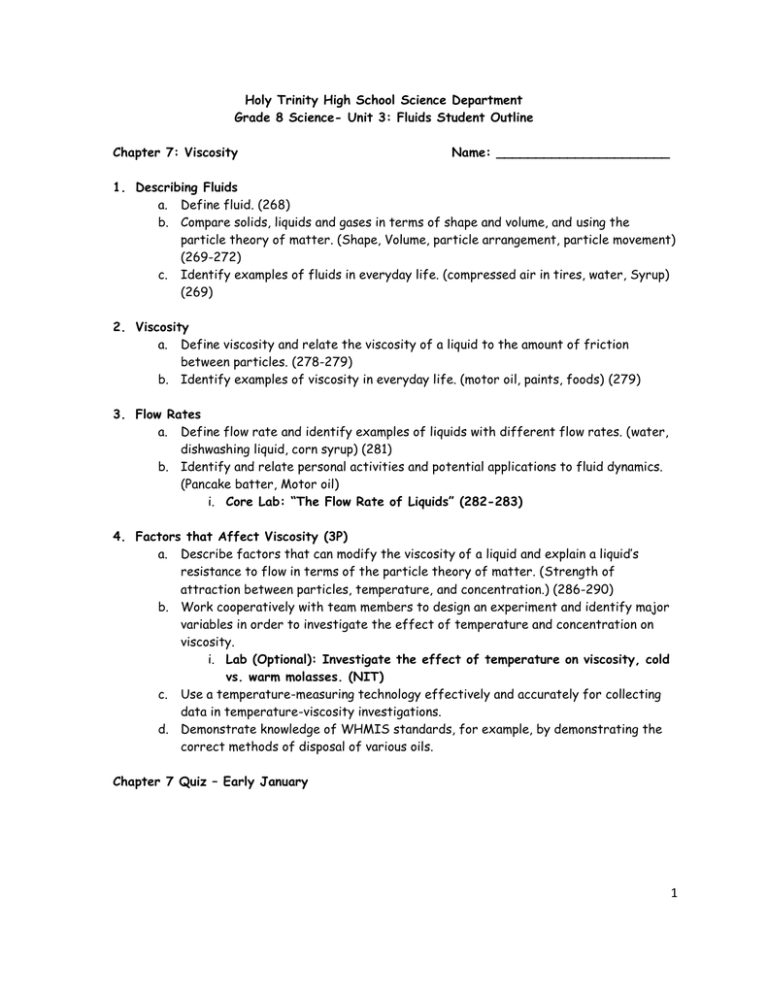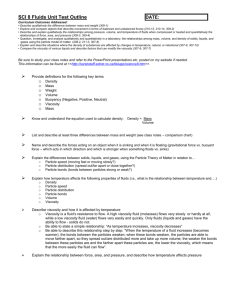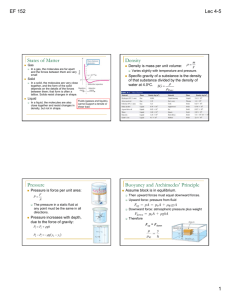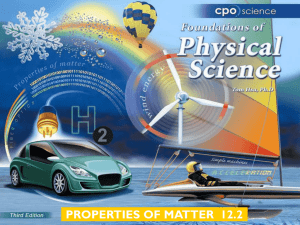Fluids Student Study Outline
advertisement

Holy Trinity High School Science Department Grade 8 Science- Unit 3: Fluids Student Outline Chapter 7: Viscosity Name: ______________________ 1. Describing Fluids a. Define fluid. (268) b. Compare solids, liquids and gases in terms of shape and volume, and using the particle theory of matter. (Shape, Volume, particle arrangement, particle movement) (269-272) c. Identify examples of fluids in everyday life. (compressed air in tires, water, Syrup) (269) 2. Viscosity a. Define viscosity and relate the viscosity of a liquid to the amount of friction between particles. (278-279) b. Identify examples of viscosity in everyday life. (motor oil, paints, foods) (279) 3. Flow Rates a. Define flow rate and identify examples of liquids with different flow rates. (water, dishwashing liquid, corn syrup) (281) b. Identify and relate personal activities and potential applications to fluid dynamics. (Pancake batter, Motor oil) i. Core Lab: “The Flow Rate of Liquids” (282-283) 4. Factors that Affect Viscosity (3P) a. Describe factors that can modify the viscosity of a liquid and explain a liquid’s resistance to flow in terms of the particle theory of matter. (Strength of attraction between particles, temperature, and concentration.) (286-290) b. Work cooperatively with team members to design an experiment and identify major variables in order to investigate the effect of temperature and concentration on viscosity. i. Lab (Optional): Investigate the effect of temperature on viscosity, cold vs. warm molasses. (NIT) c. Use a temperature-measuring technology effectively and accurately for collecting data in temperature-viscosity investigations. d. Demonstrate knowledge of WHMIS standards, for example, by demonstrating the correct methods of disposal of various oils. Chapter 7 Quiz – Early January 1 Chapter 8: Density, Mass and Volume 5. Defining Density a. Describe the relationship among the mass, volume, and density of solids, liquids and gases using the particle model of matter. (302-304) b. Describe the relationship between state of matter (solid, liquid or gas) and density using the particle model of matter. (303-306) 6. Determining Density a. Describe the relationship between mass, volume and density. (310) b. Analyze quantitatively the density of various substances. (311-314) i. Calculate the density of a material, given mass and volume. ii. Calculate the mass of a material, given density and volume. iii. Calculate the volume of a material, given density and mass. c. Measure and calculate the density of various objects. (irregular shaped objects, liquids, granular objects and regular shaped objects) i. Core Laboratory Activity “Determining Densities” P. 316-319 7. Changes in Density a. Explain the effects of changes in temperature on the density of solids, liquids, and gases and relate the result to the particle model of matter. (324) b. Identify examples of density changes (resulting from a temperature change) in everyday life. (hot air balloons, warm vs. cool tire pressure and water in its three states) (324-326) c. Describe situations in life where the density of substances naturally changes or is intentionally changed. (drying of wood, hot air balloons, salt water being easier to float in) (324-326) Terms to Know: Fluid WHMIS Volume Particle Theory Concentration Viscosity Density Friction States of Matter Flow Rate Mass Chapter 8 Quiz – Early February 2 Holy Trinity High School Science Department Grade 8 Science- Unit 3: Fluids Student Outline Chapter 9: Impact of Forces on Fluids Name: ______________________ 8. Balanced and Unbalanced Forces a. Define force. (334) b. Define balanced and unbalanced forces. (334-335) c. Describe qualitatively the difference between mass and weight. (335) 9. Buoyancy and Buoyant Forces a. Define buoyant force. (336) b. Apply the concept of balanced and unbalanced forces to the buoyancy and weight of an object to explain why it sinks or floats. (336-338) 10. Applications of Buoyancy a. List examples of materials that may sink or float, depending on the application. (wooden boats vs. a water logged stick, metal block vs. metal boats, a sealed, empty plastic bottle vs. a plastic bottle full of water) b. Define average density. (340) i. Indicate that an object will float if it is less dense than the fluid in which it is immersed. ii. Indicate that an object will sink if it is denser than the fluid in which it is immersed. c. Provide examples of technologies that have been developed because of our understanding of density and buoyancy. (personal flotation devices - life jackets), submarines, hot air balloons) (339-341) 11. Pressure a. Define pressure (348-349) i. Define the Pascal (Pa) unit (350-351) b. Calculate unknown quantity in pressure problems. (350-353) i. Calculate the pressure, given force and area ii. Calculate the force, given pressure and area iii. Calculate the area, given pressure and force c. Define atmospheric pressure. (355) 3 12. Pascal’s Law, Hydraulics and Pneumatics a. State Pascal’s law. (356) b. Identify examples of applications of Pascal’s law. Include: (a car lift or hoist, an hydraulic jack, automobile braking system) (356-359) c. Identify a liquid as an incompressible fluid (ie. definite volume) (354) d. Define hydraulic system. (356) e. Describe the science underlying hydraulic technologies. (354, 356-358) f. Identify a gas as a compressible fluid (ie. indefinite volume) (354) g. Define pneumatic system. (358-359) 13. Physical Properties of Gases a. Explain qualitatively the relationship among pressure, volume, and temperature when liquid and gaseous fluids are compressed or heated. (364-370) i. Indicate that increasing the temperature of a gas results in an increase in volume (pressure being held constant) ii. Indicate that increasing the pressure on a gas results in a decrease in volume (temperature being held constant) iii. Indicate that increasing temperature of a gas results in an increase in pressure (volume being held constant) b. Provide examples illustrating the relationship among pressure, volume and temperature when gaseous fluids are compressed or heated. (369-370) i. propane cylinders (increase in pressure with a decrease in volume at constant temperature) ii. heating an aerosol can result in an explosion (increase in temperature resulting in an increase in pressure, at constant volume) Terms to Know: Force Buoyant Force Pascal Propane Cylinder Balanced Forces PFD – Personal Flotation Device Atmospheric Pressure Aerosol Can Unbalanced Forces Submarine Mass Weight Hot Air Balloon Pressure Pascal’s Law Hydraulic System Pneumatic System Unit Test – February 4





